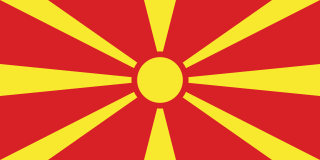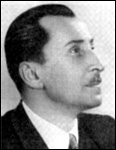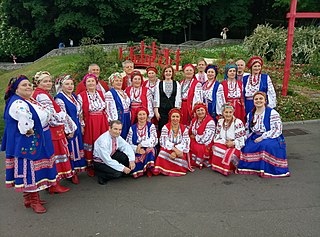This is a list of notable folk dance performance groups, listed by country of origin.
Contents
- Bulgaria
- Canada
- China
- Croatia
- Macedonia
- Estonia
- Honduras
- Mexico
- Philippines
- Poland
- Turkey
- Ukraine
- United States
This is a list of notable folk dance performance groups, listed by country of origin.
Ukrainian music covers diverse and multiple component elements of the music that is found in the Western and Eastern musical civilization. It also has a very strong indigenous Slavic and Christian uniqueness whose elements were used among the areas that surround modern Ukraine.

The Macedonian music refers to all forms of music associated with ethnic Macedonians. It share similarities with the music of neighbouring Balkan countries, yet it remains overall distinctive in its rhythm and sound.
This is an alphabetical index of articles related to dance.

Hopak is a Ukrainian folk dance originating as a male dance among the Zaporozhian Cossacks, but later danced by couples, male soloists, and mixed groups of dancers. It is performed most often as a solitary concert dance by amateur and professional Ukrainian dance ensembles, as well as other performers of folk dances. It has also been incorporated into larger artistic opuses such as operas, ballets and theatre.

Ukrainian dance mostly refers to the traditional folk dances of the Ukrainians as an ethnic group, but may also refer to dances originating from the multiple other ethnic groups within Ukraine.

Pavlo Pavlovych Virsky, PAU, was a Soviet and Ukrainian dancer, ballet master, choreographer, and founder of the Pavlo Virsky Ukrainian National Folk Dance Ensemble, whose work in Ukrainian dance was groundbreaking and influenced generations of dancers.

Baile folklórico, "folkloric dance" in Spanish, also known as ballet folklórico, is a collective term for traditional cultural dances that emphasize local folk culture with ballet characteristics – pointed toes, exaggerated movements, highly choreographed. Baile folklórico differs from danzas and regional bailes. Although it has some association from “danzas nationalists". Folk dances", that is, "dances that you will find in the villages, not on stage" were researched and disseminated by Alura Angeles de Flores. Each region in Mexico, the Southwestern United States and Central American countries is known for a handful of locally characteristic dances.

Ballet Folklórico de México is a Mexican folkloric ensemble in Mexico City. For six decades it has presented dances in costumes that reflect the traditional culture of Mexico. The ensemble has appeared under the name Ballet Folklórico de México de Amalia Hernández.

Amalia Hernández Navarro was a Mexican ballet choreographer and founder of the world-renowned Ballet Folklórico de México.

Ballet Folklorico en Aztlan (BFA) is a Chicano dance company focusing on Mexican folklore, and blending traditional dance with contemporary movements. The group was founded in 1967 by Hermina Enrique. Currently, her daughter, Viviana Enrique Acosta, is the Artistic Director. The members of BFA were instrumental in founding the Centro Cultural de la Raza which was the first home of the BFA.
Aspen Santa Fe Ballet (ASFB) is a multi-faceted arts organization that nurtures and manifests the love of dance across a spectrum of programs for the cultural enrichment of Aspen, Colorado, and Santa Fe, New Mexico—and beyond.

Ukrainian folk music includes a number of varieties of traditional, folkloric, folk-inspired popular music, and folk-inspired European classical music traditions.
Staś Kmieć is a theater and dance choreographer, specializing in a variety of styles of dance: theatre dance, character/folk, period/historical, social/ballroom, ballet, and concert dance.
Guillermo Keys-Arenas — was a dancer and choreographer. He is remembered for his eight-year association with Ballet Folklorico de Mexico for which he was artistic coordinator and ballet master, as well as his contribution to dance in Australia.
The Mexcaltitán Ballet was founded in 1989 by choreographer Sergio Eugenio García Pérez and is based in the western state of Nayarit in Mexico. It was founded to promote and consolidate Mexican folk dance, with a focus on the state of Nayarit, making it unique. However, the troupe also performs other dances from Latin America and contemporary dance as well as Mexican styles. The dancers are young and trained by the company to perform. The organization is divided into two sections, the main group and a children’s group called the Mexcaltitán Infantil, geared to very young dancers with the aim of training them to become part of the main group. Today, the troupe is supported by the Nayarit state government and García Pérez remains as the general director.

Folk dance of Mexico, commonly known as baile folklorico or Mexican ballet folk dance, is a term used to collectively describe traditional Mexican folk dances. Ballet folklórico is not just one type of dance, it encompasses each region's traditional dance that has been influenced by their local folklore and has been entwined with ballet characteristics to be made into a theatrical production. Each dance represents a different region in Mexico illustrated through their different zapateado, footwork, having differing stomps or heel toe points, and choreography that imitates animals from their region such as horses, iguanas, and vultures.

Rafael Zamarripa Castañeda is a Mexican painter, sculptor, designer, dancer and choreographer.
Silvina Fabars is a Cuban folk dancer and ballerina who is the principal dancer of the National Folkloric Ensemble of Cuba and a noted folk dance instructor throughout Latin America and Europe. She has won numerous awards and recognition throughout her career including the Vanguardia Nacional, the Distinción por la Cultura Nacional, and the Alejo Carpentier Medal. In 2014, she was honored as the recipient of the National Dance Prize of Cuba.

Ballet Folklórico de Honduras Oro Lenca is a Honduran folkloric ballet troupe in La Esperanza. It was founded in 2008 and presents dances and costumes that reflect the traditional culture of Honduras. This dance troupe hosts an annual folk dance festival, El Grande de Grandes, and represents Honduran culture internationally. It also mentors nascent dance groups in villages, towns, and cities of Honduras. In November 2015, the National Congress of Honduras designated Ballet Folklórico Oro Lenca Patrimonio Cultural de la Nación, and subsequently designated Ambassadors of Art and Culture by executive decree.